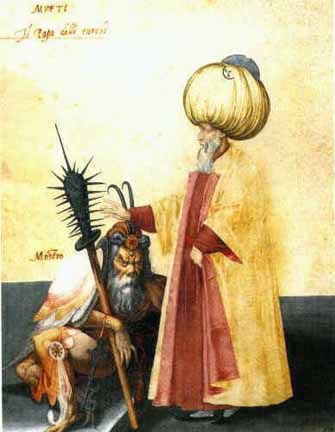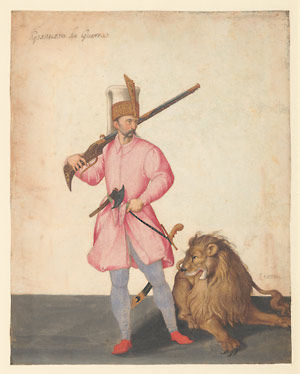Jacopo Ligozzi (Verona 1547 - 1627 Florence), A Turbanned Pasha with an Elephant
Jacopo Ligozzi (Verona 1547 - 1627 Florence), A Turbanned Pasha with an Elephant
Tempera heightened with gold. inscribed upper left: Bassà over Chiaus et spaì and to the right of the elephant's thigh: Elefante. 278 by 221 mm. Estimate 340,000—380,000 GBP
PROVENANCE : Private Collection, England;
With Trinity Fine Art, London, by 1998
NOTE : This exceptional drawing comes from an album, of which twenty-nine pages are known, twenty in the Uffizi, Florence,1 and nine others, including this one, in other public and private collections.2 Ligozzi probably painted these subjects in the very earliest years of his Florentine sojourn, between 1580 and 1585, while working at the court of the Grand Duke Francesco I de' Medici. The source of the commission is not known, but Lucilla Conigliello has recently proposed that rather than one of the Medici, the patron may have been the important collector Niccolò Gaddi, who was a great admirer of Ligozzi's work as a scientific illustrator. The Gaddi family owned the album before it went, in about 1740, to the famous Doccia porcelain factory near Florence, which had been founded by Marchese Carlo Ginori in 1735. A variety of Turkish subjects from this album were then used as models for the decoration of exquisite porcelain objects, which are today to be found in museum collections worldwide.3 The drawings from the album were probably dispersed soon afterwards and the Uffizi acquired their group as a gift from the sculptor Niccolò Bazzani in 1867.4
Following the defeat of the Turks at the Battle of Lepanto in 1571, there was a notable surge in interest in Turkish subjects. Ligozzi never travelled to Turkey himself, and loosely based his drawings on the illustrations in the Venetian edition of the Frenchman Nicolo de' Nicolay's book, Le navigationi et viaggi fatti nella Turchia, which was published in Italian, first in Antwerp in 1576 and then in Venice in 1580. The complete album must have been an incredible assembly of exotic and detailed images, showing figures in their elaborate costumes, often paired with fantastic or symbolic animals, and sometimes, as here, heightened with gold, to enhance their preciousness. The subtlety and precision of the artist's work reflect his early training as a miniaturist, a skill for which he was admired by the Medici court, and which he himself clearly valued, as he continued to sign his works Jacopo Ligozzi miniator as late as 1592.
The inscription on this drawing identifies the figure as a Pasha (Bassà in the Italian of the day), a high official in the Ottoman empire. This was normally a much higher rank than the Chiaus, a sort of Imperial envoy, also mentioned in the inscription, although a contemporary of Ligozzi makes reference to a Chiaus Pasha. William Harebrowne, the English Ambassador to the Sublime Porte during the reign of Elizabeth I, describing the various salaries of high Ottoman officials noted that the Sultan paid the "Chiaus Pasha, captain of the pensioners, one hundred and twenty aspers the day, and amounteth to, by the year, in sterling money, two hundred threescore and two pounds, sixteen shillings." The other term in the inscription, "spaì" was the contemporary Italian spelling of the Turkish work sipahi which was an elite unit of the Ottoman cavalry. As the requirement for membership in this corps was the ownership of land (and pure Turkish ancestry), the term was sometimes used for that class as a whole.
Jacopo Ligozzi arrived in Florence in 1577 from his native Verona and acquired his fame during his subsequent ten-year service to the Grand Duke of Tuscany, Francesco I de' Medici. He played a central role in the artistic life of the ducal court, executing exquisite naturalistic and scientific studies of plants and animals, works on paper or parchment for which he is still admired today. It was a period of great interest in the arts and sciences, and the patronage of the court encouraged and made fashionable the production of such superb, luxurious works of art for a small elite of connoisseurs and refined collectors.
1. See A. Forlani, 'Jacopo Ligozzi nel Gran Serraglio', FMR, n. 1, 1982, pp.72-103, all reproduced
2. e.g. The Metropolitan Museum of Art (inv. no. 1997.21); J. Paul Getty Museum (inv. no. 91.GG.93); for a complete account of the drawings from the album see N. Strasser, Raphael to Renoir, Drawings from the Collection of Jean Bonna, exhib. cat., New York, Metropolitan Museum of Art, 2009, under no. 22
3. See L. Ginori Lisci, 'Una serie di vassoi di porcellana della prima epoca di Doccia', Faenza, 6, 1955, pp.127-132
4. See A. Forlani, op.cit., p. 77
Old Master Drawings. 08 Jul 09 11:30 AM. London photo courtesy Sotheby's www.sothebys.com
COMMENTAIRE : This drawing was sold before by Sotheby's New York: Thursday, January 25, 2007, [Lot 52] Important Old Master Paintings for 420,000 USD . In the same auction, were two others drawings by Jacopo Ligozzi :
Jacopo Ligozzi (Verona 1547 - 1627 Florence), A Turbanned Pasha with an Elephant, tempera and shell gold, with traces of black chalk, on paper; inscribed upper left Lo Habitto delle done greche maritate di Costantinopoli et Pera; 11 by 8 3/4 in.; 27.9 by 22.7 cm. Estimate 300,000—400,000 USD. Lot Sold 264,000 USD. photo courtesy Sotheby's. Jacopo Ligozzi (Verona 1547 - 1627 Florence) Two Solak Archers with a Dog, tempera and shell gold on paper; inscribed upper left SVLACCHI / Sonno quelli che caminano a piedi / dinanci al grn Sigor Co Arch, frecie; 10 7/8 by 8 3/4 in.; 27.6 by 22.2 cm. Estimate 350,000—450,000 USD. Lot Sold 420,000 USD photo courtesy Sotheby's
Jacopo Ligozzi, Full-length Portrait of the Sultan Selim II with a Dragon. Between 1580 and 1585. Collection of Jean Bonna
In another one, it is said that around 1576, Jacopo Ligozzi created a cruel miniature entitled Mufti -11 Papa Delli Turchi (a mufti depicted as the pope of Turkey) with a mostro, thus insinuating that Turkish religious leaders were masters of "monsters"...
Jacopo Ligozzi, The Mufti and the Monster, 1576 - 1580
Another Ligozzi's drawing is in the J. Paul Getty Museum, Los Angeles :
Jacopo Ligozzi, Italian, An Azappo Archer with a Cheetah, about 1575. Brush, pen and brown ink, tempera, and gold paint, 11 1/16 x 8 3/4 in. 91.GG.53. J. Paul Getty Museum, Los Angeles

/https%3A%2F%2Fprofilepics.canalblog.com%2Fprofilepics%2F1%2F0%2F100183.jpg)
/https%3A%2F%2Fstorage.canalblog.com%2F03%2F02%2F119589%2F96711876_o.jpg)
/https%3A%2F%2Fstorage.canalblog.com%2F11%2F31%2F119589%2F94773502_o.jpg)
/https%3A%2F%2Fstorage.canalblog.com%2F20%2F83%2F119589%2F94772815_o.jpg)
/https%3A%2F%2Fstorage.canalblog.com%2F26%2F72%2F119589%2F75604929_o.jpg)
/https%3A%2F%2Fstorage.canalblog.com%2F59%2F60%2F119589%2F26458628_o.jpg)










/http%3A%2F%2Fstorage.canalblog.com%2F41%2F70%2F119589%2F71222445_o.jpg)
/http%3A%2F%2Fstorage.canalblog.com%2F84%2F50%2F577050%2F40250600_p.jpg)
/http%3A%2F%2Fstorage.canalblog.com%2F26%2F27%2F119589%2F126624263_o.jpg)
/http%3A%2F%2Fstorage.canalblog.com%2F30%2F23%2F119589%2F126609221_o.png)